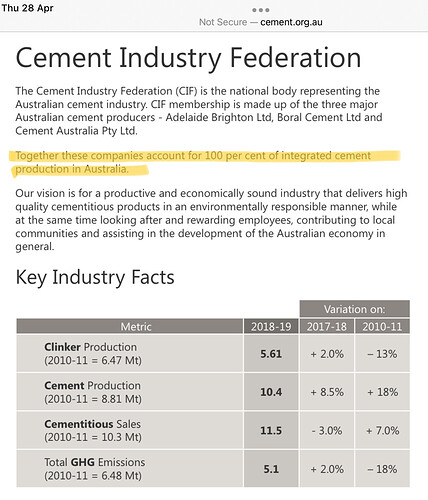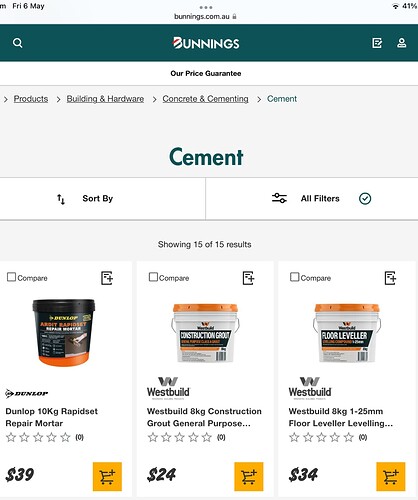I recently needed a small amount of cement to do a job around the home & was able to buy a small package from a hardware. When I got it home & read the information on the labelling on one part in small letters it said it was “Made in Vietnam by Dingo Building Products” on another in more prominent type it was “Manufactured by Dingo Cement Australia”.
I’ve always considered the terms Made & Manufactured to be synonymous so was wondered where it actually originated from.
The company website says it has experience in cement dry mix manufacturing, packaging and material sourcing & has manufacturing facilities in Vietnam. So it seems as if it’s most likely made in Vietnam & packaged in Australia.
It’s not really an issue as to its actual origin except that it’s had to be shipped a long way to get put into a bag for sale!
I found it confusing & wondered whether this is deliberately attempting to appear to be an Australian product & confuse its actual origin.
Perhaps it caters to a specific constituency known to support government(s)? The ‘definitions’ are described here
Cement as in the raw powder or a blended mix which is often also referred to as cement by us home users?
Dingo Building Products is one company that Bunnings purchases cement and cement products from. Marketed under Bunnings ‘Bastion’ trademark.
https://dingocement.com.au/wp-content/uploads/2017/05/Bastion-General-Purpose-Cement.pdf
If you purchased a dry mixed product, aka “pre-mix” the gravel, sand etc may have been added to the imported cement powder in Australia by Dingo BP. Hence a blend of local and imported ingredients.
There are 3 Australian business that manufacture cement (cement powder) as well as blended products (dry mixes).
There are various reasons why it is cheaper to produce cement in SE Asia compared to Australia. Environmentally as well as for other inputs.
Looking at the link you supplied PhilT, if the product was just packaged in Australia it can’t be considered to be made in Australia.
Packaging a product is not a substantial transformation.
Example: a business imports artificial sweetener in bulk and packs it into single use sachets. The sweetener has not been substantially transformed and the business cannot claim that the sachets of sweetener have been made in Australia.
So this doesn’t answer the question as I don’t know whether the cement originated from Vietnam or not. If it was then the company is being deceptive.
Mark_m, it was just the raw powder, nothing added.
That is true. It was also historically the case where some ‘Australian Made’ referred to the package not the contents!
The authoritative ‘law’ was linked into the FAQ.
The following from the link I included in my previous post re 3 Australian cement companies may clarify.
Dingo BP may be importing cement in bulk, or more conveniently as cement clinker which can be easier to handle and store for longer periods of time. If imported as clinker it requires crushing/grinding with the addition of some gypsum to produce what we know as Portland or GP cement.
The ACCC use the terms Made & Manufactured synonymously. If as Mark_m has said the cement is imported as clinker then there could have been what might be interpreted as substantial transformation in Australia to allow it to be labelled as manufactured here even if it was Made in Vietnam!
Doesn’t say manufactured in Australia, it is saying it is manufactured by Dingo Cement Australia in Vietnam. No untruth there. The Australian company (ie the company is a Company registered in Australia not necessarily manufactures in Australia) manufactures the cement in Vietnam.
From their website “Our purpose-built manufacturing facilities in Vietnam were built to supply the Australian and International markets with cement dry mix products. In 2017 we started packaging locally in Australia raw building materials”. They own the facilities (or lease them) in Vietnam so the company does manufacture the product.
They make no claims about packaging here, it appears from the labelling you quoted. All they claim is the company that manufactures the product is an Australian company. A name of their business is “Dingo Cement Australia”. They have a trading name here and the Dingo Cement Pty Ltd: company ACN is 095646067 and ABN is 53095646067. Dingo Cement is the registered trading name for the ATO/ASIC and in Vietnam it is Dingo Building Products as a subsidiary of the parent company.
It is manufactured by the company Dingo Cement Australia in Vietnam. It is made in Vietnam.
The made in may indicate that it contains non-Vietnamese ingredients, but blended into the final product in Vietnam before being shipped to Australia.
You’re most likely correct grahroll & it may be legal, but I find the labelling very misleading, giving the buyer the impression it’s manufactured locally.
Thanks to all who replied.
There are many examples of this. Others include…
- Australian or locally owned on the label, but sells imported products
- Uniquely Australian words in the brand name (such as Australian animal, plant or location names) but the product is imported
- Well known Australian brands, but import products
- Using the Australian flag on labels when the product is fully imported but processed in Australia
All these can give the wrong impression and why understanding country of origin labelling is important.
The assumption is that the country of origin is in fact readily apparent from the labelling.
I looked to Bunnings web site and their brand - Bastion GP cement.
It’s not evident from the pack shots or online content whether the product is Australian or imported?
Reality is a number of competitors label their products as Australia GP Cement or Australian GB Cement. Add an Aussie flag and ‘Australian Company/Owned’ etc and it’s all one might see without man handling the 20kg bags and looking for the fine print. Is it misleading?
The labelling on the packaging has one purpose. To convince the customer to buy the product. If the bold print on the front of the bag announced ‘Vietnamese Cement’ what would any average Aussie answer about the source of the product? The intent is self evident, even if legislation might permit otherwise!
Prepackaged Portland cement imported to Australia needs to be correctly labelled.
If imported in bulk these requirements do not apply?
Mark, it sounds like you are talking about concrete, not cement. Concrete - Wikipedia. Concrete is made using cement.
Thank you, I’m confident we both know the difference.
In the trade one thing?
In the local super dooper green home handyman hardware store?
‘https://www.bunnings.com.au/products/building-hardware/cement-concreting/cement?gclid=EAIaIQobChMIwPab6KfJ9wIVbZlmAh1cSwM3EAAYASAAEgIQH_D_BwE&gclsrc=aw.ds
Bags of concrete mix are further down the page for those who follow the link, along with grout and ….
I was hopeful of accommodating a wider group of Aussies, given in common lay usage ‘cement’ is used to describe a wide range of products. Apologies if it was not as clear as intended. Having turned down a past opportunity to manage a batching operation for one of the big names, they’ll be pleased to know I thought carefully about the outcome. ![]()
The OP seemed to understand the need to clarify and responded accordingly. It is relevant in considering imported vs local content. There are various permutations for a product from 100% Australian raw materials, processing and packaging through to 100% OS product imported fully packaged.
With store brands such as ‘Bastion’ Bunnings are free to change supplier. The supplier and hence origins can vary by type, batch and yearly contract.
This discussion is about cement & its’ labelling, not concrete.
I think your original question has been answered.
The cement is made in Vietnam.
It is manufactured by an Australian company, who owns the plant in Vietnam.
It doesn’t say ‘product of Australia’.

